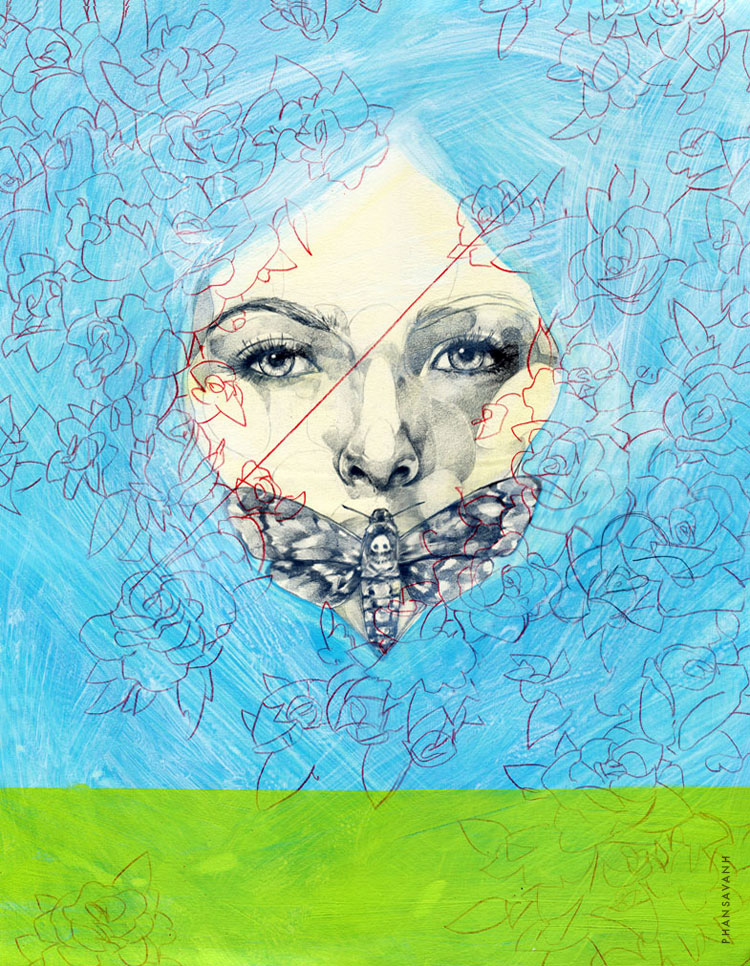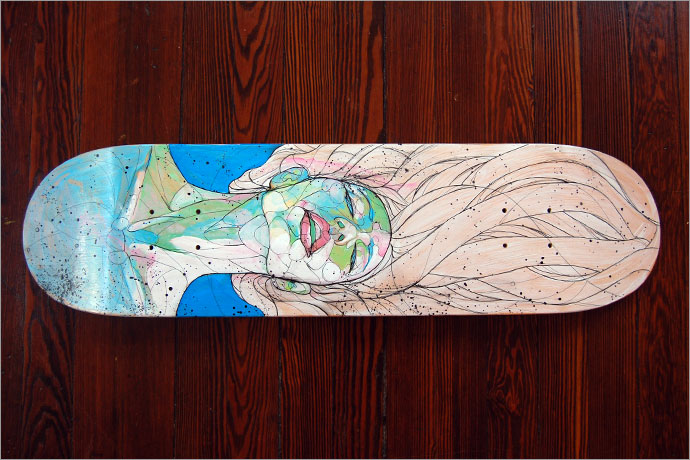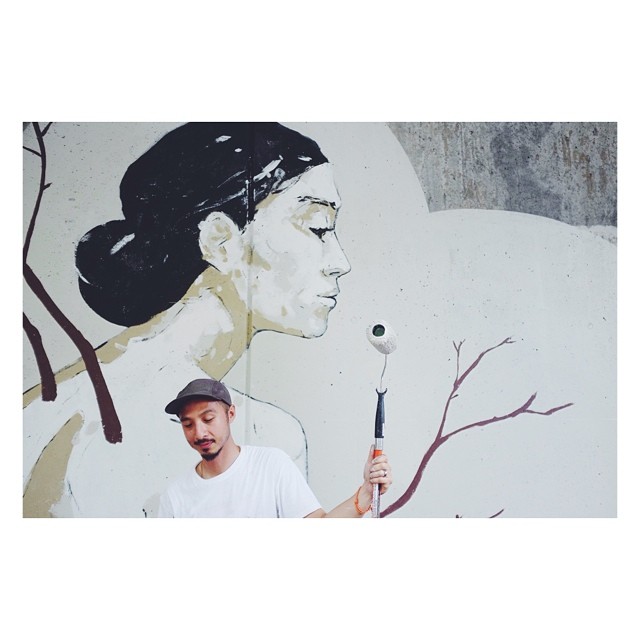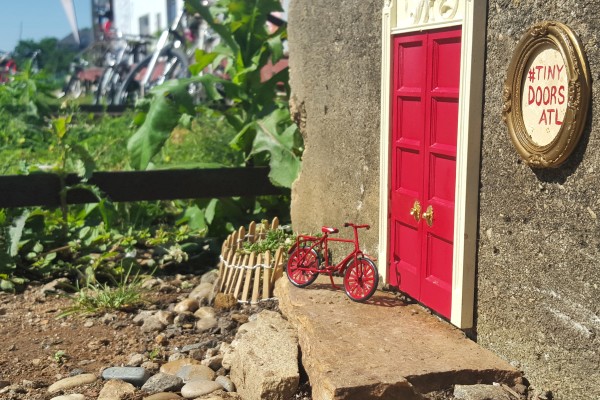 Decatur-based artist Sanithna Phansavanh, 35, came to Atlanta via Kansas City, Missouri, his hometown where he and his family lived through a refugee program after his mother escaped Communist Laos in the 1970s. Now, with deep Southern roots and a rewarding design gig at the American Cancer Society, Phansavanh crafts delicate, ethereal drawings and paintings that can be seen in mural form across from 97 Estoria, in daily drawings posted on his Instagram, and, as of Aug. 2, exhibited at Beep Beep Gallery.
Decatur-based artist Sanithna Phansavanh, 35, came to Atlanta via Kansas City, Missouri, his hometown where he and his family lived through a refugee program after his mother escaped Communist Laos in the 1970s. Now, with deep Southern roots and a rewarding design gig at the American Cancer Society, Phansavanh crafts delicate, ethereal drawings and paintings that can be seen in mural form across from 97 Estoria, in daily drawings posted on his Instagram, and, as of Aug. 2, exhibited at Beep Beep Gallery.
Here, Phansavanh talks to CommonCreativ ATL about humbling moments, why he makes art, his thoughts on the local creative scene and more.
CC: How has your background shaped you as an artist?
SP: I was fairly impoverished for most of my childhood, so improving the quality of life has always been a strong undercurrent for me. I was groomed to be a white collar professional, like a doctor or a lawyer, and I stayed on that path until I discovered that graphic design was a suitable enough alternative (white collars and a pesky desire to create art don’t really complement each other).
Growing up as a skateboarder, I naturally gravitated towards the application of art as graphics, from decks to apparel to videos to packaging, and that led to a realization in college that I could build financial stability through commercial art. I abandoned a few majors (architecture, psychology, fine art), hedged my bets, and pursued design as a way to put food on the table.
CC: What’s your artistic process?
SP: My process varies, but it primarily involves words. I’ll come across certain words, phrases from books, lyrics, or conversations, and they’ll help to clarify nascent ideas that I already have. As I process those thoughts, images will begin to form, and I’ll play with them in my sketchbook or as rough pieces until the right mood or quality is found. It’s like excavating an archaeological site. I just keep brushing away dirt until something is revealed.
Recently, I’ve been working in my sketchbook and creating images without an agenda, just drawing and painting so that I can try out techniques or reinforce particular skills. I’ve found that I get the same benefit, that my ideas formulate as I let my mind wander, but I also get the added bonus of exercising skills that I can apply to more polished pieces. This process is different for me and I love how it inherently allows me to use “failures” as learning experiences.
CC: Tell me about your design gig at the American Cancer Society.
SP: Coming out of school, you have these glorified plans of doing amazing work with amazing clients, but the reality is that those two things, amazing work and amazing clients, don’t overlap too often.
I was working for an advertising agency, hating everything about design—the spirit, the work, the clients, the hours—when the opportunity came along for me to be the art director for the American Cancer Society’s digital experience team. I hesitated initially, but I’m so happy that I signed on because it reinvigorated my love for design. There’s a clear (and noble) purpose for design and I get to collaborate with intelligent, talented, and passionate people on some great projects.
I help define and execute creative strategy for the brand’s digital touch points, running the spectrum from sites to apps to email to social media. It’s been my favorite job and the most rewarding job that I’ve ever had.
CC: What’s your design philosophy?
SP: Design is a conduit to deliver ideas, amplifying its purpose through messaging and aesthetic. Design should be intricately embedded into an idea, but, ultimately, design can’t exist without a coherent idea. If you compare design to a line of dialogue in a movie, what’s said is the idea and how it’s spoken (by whom, in what genre, at what speed, at what volume, in what concentration, etc.) is the design.
CC: What are some of your favorite themes to explore in your work?
SP: Examining the human condition is a core theme. My work defaults to deconstructions of who we are and what we do as humans. Life, death, and the dynamics between drive everything for me, so I try to find reflections of us in various explorations… from simple portraits to fuller, personal narratives.
CC: Tell me about your portrait work—you did a project where people sent in photos of themselves and you drew them?
SP: Several years back, people shared their favorite songs with me and I visually interpreted the lyrics that stood out to me. When I set up a daily drawing challenge for myself this past year, I wanted to incorporate that “audience participation” into it somehow.
As a part of my daily practice, I try to sketch the figure as much as possible, but, because my time is limited, I mostly draw from reference images. So, I’ve asked for people on Instagram to tag their selfies with #OccupyIdleHands (I ended up calling my challenge “Occupy Idle Hands”) to help give me resource material. The portrait project is still ongoing, but I have plans to augment it and make it more involved. I enjoy the interactivity and I want to dial up the engagement.
CC: What’s been one of your proudest art-related moments?
SP: “Proud” is a difficult word for me to use. I’ve had my share of success with art in my life, but they’ve all yielded this odd mixture of disbelief and elation. Like, “What’s the catch? You honestly like my art? Holy shit, this is exactly what I want in life. You better not be playing with my emotions.” I alternate between wanting to kiss people and wanting to cut people whenever I show my art.
I remember one time in college, my class’ work was hanging in the hallway of the school. I was walking to the studio and I noticed that a girl had pulled up a chair next to my piece and she was copying my drawing into her sketchbook. I kept walking because I didn’t (and still don’t) know how to react to having someone’s attention like that. When all you want as an artist is to have people enjoy your work, it feels pretty surreal to actually get that. So, more than anything else, I have humbling moments.
CC: Why do you make art?
SP: I am filled with existential angst (to obnoxious levels, honestly). I used to throw around words like “legacy” and “mark” to reinforce my need to matter, and art was my (egocentric and self-absorbed) way of declaring and broadcasting that I existed. Now, it’s more about the enjoyment of creating. I no longer have any self-aggrandizing misgivings because I know that, in the larger scheme of things, who I am and what I do doesn’t elevate me above anything else. I am a manifestation of The Universe, just like everything else, and my manifestation just happens to lie with art. When I think of art in that way, that it’s an outlet of The Universe’s creative energy, everything gets perspective. I’m able to celebrate and relish what I do without trying to assign purpose to it. I make art because it is my purpose. Nothing else is as honest.
CC: What are some of your favorite art happenings, organizations or people in Atlanta?
SP: I’m so incredibly enamored with gloATL and their performances. What they do—inserting art into common spaces and having it command attention—delights me to no end. Especially here in the South, where, historically, art has never been prioritized, gloATL gives art a platform that’s accessible, immediate, and engaging. They make art experiential, rather than ornamental, and that’s so inspiring—kudos to Lauri Stallings and her team.
CC: What do you think of the Atlanta arts scene?
SP: The current scene is great because its identity hasn’t solidified yet. It’s burgeoning, which means there are growth pains, but that growth is really exciting.
Negatively, there aren’t too many levels to the game. There’s basically just low-brow art and high-brow art, and the gradation between those two levels, where it’s potentially more accessible, isn’t very developed. It’s difficult for artists to thrive in an environment with limited opportunities. On the flip side, that’s also the positive. The lack of an established structure means that artists instigate opportunity for themselves. Success is up for grabs here in Atlanta and there are several artists who do exactly that. They are talented enough and have the right hustle to create rules for themselves or to bend rules to their advantage. There are wonderfully talented people doing fantastically unique things and pushing culture as far forward as possible. They are building our foundation, brick by creative brick, and they have my utmost respect.
Check out more info and art by Sanithna Phansavanh at his site, sircle.net.








